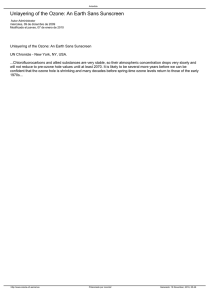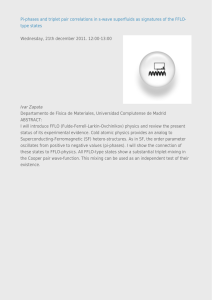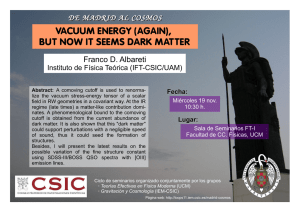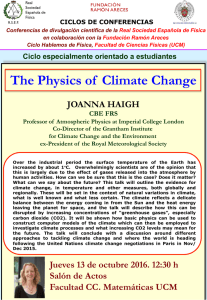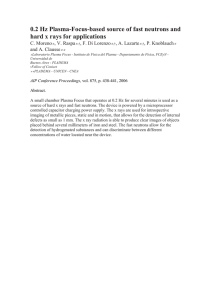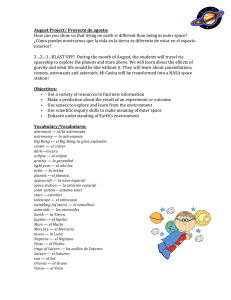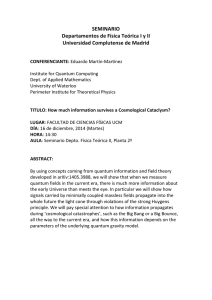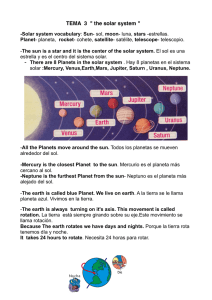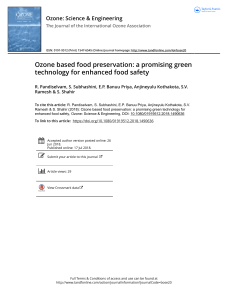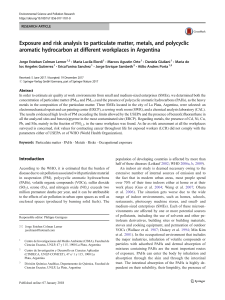Performance of the Bulgarian WRF
Anuncio
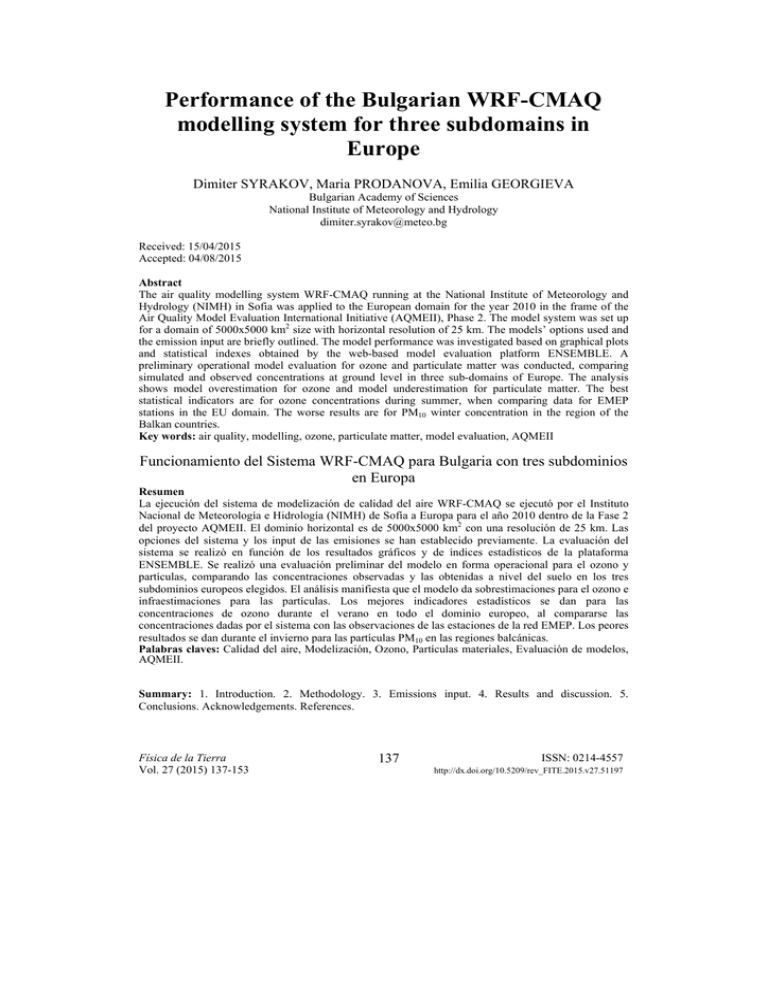
Performance of the Bulgarian WRF-CMAQ modelling system for three subdomains in Europe Dimiter SYRAKOV, Maria PRODANOVA, Emilia GEORGIEVA Bulgarian Academy of Sciences National Institute of Meteorology and Hydrology [email protected] Received: 15/04/2015 Accepted: 04/08/2015 Abstract The air quality modelling system WRF-CMAQ running at the National Institute of Meteorology and Hydrology (NIMH) in Sofia was applied to the European domain for the year 2010 in the frame of the Air Quality Model Evaluation International Initiative (AQMEII), Phase 2. The model system was set up for a domain of 5000x5000 km2 size with horizontal resolution of 25 km. The models’ options used and the emission input are briefly outlined. The model performance was investigated based on graphical plots and statistical indexes obtained by the web-based model evaluation platform ENSEMBLE. A preliminary operational model evaluation for ozone and particulate matter was conducted, comparing simulated and observed concentrations at ground level in three sub-domains of Europe. The analysis shows model overestimation for ozone and model underestimation for particulate matter. The best statistical indicators are for ozone concentrations during summer, when comparing data for EMEP stations in the EU domain. The worse results are for PM10 winter concentration in the region of the Balkan countries. Key words: air quality, modelling, ozone, particulate matter, model evaluation, AQMEII Funcionamiento del Sistema WRF-CMAQ para Bulgaria con tres subdominios en Europa Resumen La ejecución del sistema de modelización de calidad del aire WRF-CMAQ se ejecutó por el Instituto Nacional de Meteorología e Hidrología (NIMH) de Sofía a Europa para el año 2010 dentro de la Fase 2 del proyecto AQMEII. El dominio horizontal es de 5000x5000 km2 con una resolución de 25 km. Las opciones del sistema y los input de las emisiones se han establecido previamente. La evaluación del sistema se realizó en función de los resultados gráficos y de índices estadísticos de la plataforma ENSEMBLE. Se realizó una evaluación preliminar del modelo en forma operacional para el ozono y partículas, comparando las concentraciones observadas y las obtenidas a nivel del suelo en los tres subdominios europeos elegidos. El análisis manifiesta que el modelo da sobrestimaciones para el ozono e infraestimaciones para las partículas. Los mejores indicadores estadísticos se dan para las concentraciones de ozono durante el verano en todo el dominio europeo, al compararse las concentraciones dadas por el sistema con las observaciones de las estaciones de la red EMEP. Los peores resultados se dan durante el invierno para las partículas PM10 en las regiones balcánicas. Palabras claves: Calidad del aire, Modelización, Ozono, Partículas materiales, Evaluación de modelos, AQMEII. Summary: 1. Introduction. 2. Methodology. 3. Emissions input. 4. Results and discussion. 5. Conclusions. Acknowledgements. References. Física de la Tierra Vol. 27 (2015) 137-153 137 ISSN: 0214-4557 http://dx.doi.org/10.5209/rev_FITE.2015.v27.51197 Syrakov et al. Performance of the Bulgarian WRF-CMAQ modelling system... Normalized reference Syrakov D., Prodanova M., Georgieva E. (2015) Perfomance of the Bulgarian WRF-CMAQ modelling system for three subdomains in Europe. Física de la Tierra, Vol. 27, 139-156. 1. Introduction Due to the extensive development during the last three decades worldwide chemical transport models (CTM) have been recognized to be a useful tool for air quality management and assessment at local, regional and global scales. Nowadays, they are able to provide researchers, decision-makers, and the general public with more reliable information on the quality of the air, and hence, they are acting as valuable tools in the development and implementation air quality regulations, emission control strategies, and air quality forecast for the protection of the human health and the environment. During the years, air quality modeling applications at regional scale have evolved from the study of photochemical air pollution episodes to multi-pollutant and multiyear integrated analysis. Major attention has been given to ground level ozone (O3) and particulate matter (PM) due to their known impacts on air quality and human health and since high levels of these pollutants have been registered in monitoring stations, even overcoming the regulation limits. O3 and PM continue to be Europe’s most problematic pollutants in terms of harm to human health. The EU-28 urban population exposure to PM levels exceeding the World Health Organization (WHO) Air Quality Guidelines (AQG) has reached 64% for PM10 in 2012. The EU-28 urban population exposed to O3 levels exceeding the WHO AQG is significantly higher, comprising 98 % in 2012 (EEA, 2014). Model capabilities in reproducing observed concentrations over EU domains have been investigated in a variety of intercomparison exercises (e.g. Vautard et al.,2007, Galmarini et al., 2012, Pernigotti et al., 2013, Bessagnet et al., 2014). The WRF-CMAQ model system, applied at the Bulgarian National Institute of Meteorology and Hydrology (NIMH) has participated in the Air Quality Model Evaluation International Initiative (AQMEII), Phase 2, launched in 2012 (http://aqmeii.jrc.ec.europa.eu). The aims of AQMEII are to build a common strategy on model development and future research priorities, and establish methodologies for model evaluation to increase knowledge on processes and to support the use of models for policy development (Rao et al., 2011). AQMEII -2 was based on one year (2010) of air quality simulations for North America and Europe performed mainly by of online coupled meteorology-chemistry regional models. NIMH participated with the off-line WRF-CMAQ modeling system, already used in the Bulgarian Chemical Weather Forecast Systems (Syrakov et al., 2013a,b). This paper presents the preliminary results of WRF-CMAQ modeling system at NIMH over three subdomains in Europe focusing on PM and O3. For the model evaluation we make use of the JRC ENSEMBLE model evaluation platform (Galmarini et al. 2001, Galmarini et al., 2004a,b, Galmarini et al. 2012) and the monitoring data gathered for the AQMEII-2 activity (Rao et al., 2012). 138 Física de la Tierra Vol. 27 (2015) 137-153 Syrakov et al. Performance of the Bulgarian WRF-CMAQ modelling system... 2. Methodology One year of simulations have been carried out using the WRF-CMAQ system consisting of: CMAQ v.4.6 - Community Multi-scale Air Quality model, (Denis et al., 1996, Byun and Schere , 2006) - the Chemical Transport Model (CTM); WRF v.3.3 Weather Research and Forecasting Model, (Skamarock et al., 2005, 2008) - the meteorological pre-processor to CMAQ; SMOKE v.2.4 - Sparse Matrix Operator Kernel Emissions Modelling System, (Coats and Houyoux, 1996, Houyoux and Vukovich, 1999) - the emission pre-processor to CMAQ. CMAQ is a 3D Eulerian photochemical dispersion model that allows for an integrated assessment of gaseous and particulate air pollution over many scales ranging from sub-urban to continental. CMAQ simulates the emission, dispersion, chemical reaction, and removal of pollutants in the troposphere by solving the pollutant continuity equation for each chemical species on a system of nested threedimensional grids. In version 4.6 of CMAQ, the gas-phase photochemistry is resolved through the Carbon Bond IV (CB4) chemical mechanism. The model contains various algorithms, e.g. for aqueous chemistry, inorganic aerosol thermodynamics/partitioning (ISORROPIA 1.7), Secondary Organic Aerosol formation/partitioning (SOAP), RADM (Regional Acid Deposition Model). The predefined mechanism configuration is set to “cb4_ae4_aq”. Fourteen σ-levels with varying thickness determine the vertical structure of CMAQ for this exercise. The Planetary Boundary Layer (PBL) is presented by the lowest eight levels. WRF is a next-generation mesoscale numerical weather prediction system designed to serve both operational forecasting and atmospheric research needs. It is a fully compressible and non-hydrostatic model with terrain-following hydrostatic pressure coordinate. The Analysis Nudging option (Four-Dimensional Data Assimilation, Stauffer and Seaman, 1990) was switched on, i.e. WRF forecast was nudged to the meteorological driving data (NCEP GFS data with spatial resolution of 1°x1° and time resolution 6 hours). WRF offers multiple physics options that can be combined in any way. Here, the well-tried and the most frequently exploited schemes were used, namely: WSM6 scheme (Hong and Lim, 2006) for microphysics; KainFritsch scheme (Kain, 2004) for cumulus parameterization; YSU scheme (Hong et al., 2006) for PBL; RRTM scheme (Mlawer et al., 1997) for longwave radiation; Dudhia scheme (Dudhia, 1989) for shortwave radiation; NOAH Land Surface Model scheme (Chen and Dudhia, 2001). The vertical structure consists of 27 layers with increasing heights. The first 9 of them form the PBL. The linking of a meteorological and chemical transport model is not a trivial issue. Since almost all meteorological models are not built for air quality modeling purposes, interface processing is needed. Such an element in Models-3 system is MCIP (Meteorology-Chemistry Interface Processor, Otte et al., 2005). Here, MCIP v.3.6 was applied. MCIP deals with issues related to data format translation, diagnostic estimations of parameters not provided by WRF (like dry deposition Física de la Tierra Vol. 27 (2015) 137-153 139 Syrakov et al. Performance of the Bulgarian WRF-CMAQ modelling system... velocities for various species), extraction of data for appropriate window domains, and reconstruction of meteorological data on different grid and layer structures. Both WRF and CMAQ utilize the Arakawa C-grid and the same map projection; thus, no special horizontal interpolation is required. However, MCIP may modify the vertical structure by interpolation between WRF layers (i.e. from the 27 WRF levels to the 14 CMAQ ones). The emission processing component SMOKE was partly used in this application because of its quite strong relation to US emission sources specification. In the NIMH model set-up, SMOKE was used only for the calculation of biogenic source emissions (BgS), exploiting the BEIS 3.13 mechanism (Schwede et al., 2005), and for merging area- sources, large -point sources and BgS- into a common CMAQ emission file. The target simulation domain covers Europe centered on point with longitude 13°E and latitude 51°N. Lambert conformal projection has been used, the horizontal grid resolution was set to 25 km, and the horizontal grid nodes were 201 x 201. The chemical boundary conditions were provided by ECMWF MACC-II project (http://atmosphere.copernicus.eu). Specifically, the MACC re-analysis dataset from the MOZART-IFS global chemical model runs was exploited. No specific data for chemical initial condition were provided. During the calculations the initial condition for each day was taken from the end of the previous one. The pollution fields for the start time of the simulations (1 January 2010 00:00Z ) were obtained by simulating the whole month of December 2009 starting with profile data provided in CMAQ repository. The computational scheme (Fig. 1) shows that for each 3-day CMAQ period a 12-hour pre-run of WRF takes place (3.5-day run of WRF). The 12-hour spin-up at each re-initialization is necessary for adaptation of the interpolated initial conditions to the model’s physics, as well as for permeating model atmosphere with reliable amount of water vapor. Figure 1. Scheme of WRF-CMAQ computations for 2010 The WRF-CMAQ modeling system was run on a 32-core server (64 cores with hyper-trading). One day simulation takes half an hour time for completing it. 3. Emissions input The anthropogenic emissions used were provided by the Netherlands Organization for Applied Scientific Research (TNO) and correspond to a recent update of the 140 Física de la Tierra Vol. 27 (2015) 137-153 Syrakov et al. Performance of the Bulgarian WRF-CMAQ modelling system... NO-MACC emissions inventory (Keunen et al., 2011, Pouliot et al., 2012). The TNO inventory consists of the anthropogenic emissions from ten SNAP sectors (energy transformation, small combustion sources, industrial combustion, industrial processes, extraction of fossil fuels, solvent and product use, road transport, non road transport, waste handling, and agriculture), and international shipping. Subject of the inventory are 8 pollutants: methane (CH4), carbon oxide (CO), nitric oxides (NOx), sulfur dioxide (SO2), non-methane volatile organic compounds (NMVOC), ammonia (NH3), Particulate Matter with d<10μm (PM10) and Particulate Matter with d<2.5μm (PM2.5). The territory covered by this inventory extends well beyond the EU boundaries and encompasses 43 countries and 5 marine areas. The resolution of the gridded emission data is 1/8º x 1/16º longitude-latitude, which is about 7 x 8 km2. The sources are specified as Area (AS) and large point (LPS) ones as well. Three processing operations were carried with this inventory, in order to from the CMAQ emission input: gridding, time/vertical allocation and speciation. The gridding is recalculation (remapping) of the inventory data to the grid used. For this purpose the web-based GIS system, created at NIMH was used. The temporal allocation consists in over-posing of temporal profiles on the annual values. The profiles (Builtjes et al., 2003) are divided into three groups – monthly, weekly, and hourly profiles. The first two are country-, SNAP- and pollutant-specific; the hourly factors refer to the local time and are SNAP-specific, only. The speciation profiles applied have been constructed on the base of US EPA ones (http://www.epa.gov/ttn/chief/emch/speciation/) using the expert approach. Coincidence between main US sources and European SNAPs was firstly obtained. The weighted averages of the respective speciation profiles were accepted as SNAPspecific splitting factors, weights being the percentage of contribution of every source type in total emission in the particular SNAP. In such a way NMVOC, PM2.5 and NOx speciation profiles were prepared. It must be noticed that the choice of US source types and the weights of their contribution to the respective SNAP emissions are in a sense subjective. More work is needed to elaborate country-specific profiles. For the vertical allocation of AS and LPS ad hoc interface programs have been created. The wild fire emissions were estimated in the frame of IS4FIRES project (http://is4fires.fmi.fi/). The emission dataset is estimated by re-analysis of fire radiative power data obtained by MODIS instrument onboard of Aqua and Terra satellites. The emission data for Europe are available with spatial resolution 0.1° x 0.1°. After temporal and vertical allocation they have been added to LPS-files. For the biogenic emissions we have used SMOKE - NMVOC emissions from vegetation and nitrous oxide emissions from soil have been estimated based on gridded land use data and current meteorology. In addition, SMOKE was used to merge the three emission files (AS, LPS and BgS) in a common CMAQ emission input – hourly data for each day of the year. The sea salt and the dust emissions were calculated by modules built in CMAQ v.4.6. 4. Results and discussion The performance of the NIMH air quality modeling system WRF-CMAQ was analyzed based on comparison with surface measurements (i.e. operational model Física de la Tierra Vol. 27 (2015) 137-153 141 Syrakov et al. Performance of the Bulgarian WRF-CMAQ modelling system... evaluation) for the whole year 2010. The tool for the evaluation was the web-based platform ENSEMBLEv5 (http://ensemble2.jrc.ec.europa.eu/public/), hosted at the Joint Research Centre (JRC, Bianconi et al., 2004, Galmarini et al., 2012). The aim of this paper is not to comment model intercomparison and AQMEII-2 results, which is done elsewhere (e.g. Im et al., 2015), but to highlight the performance of the NIMH WRF-CMAQ simulations focussing on O3 and PM10 Data from two monitoring networks were available at ground level: AIRBASE the public air quality database system of the European Environmental Agency (http://air-climate.eionet.europa.eu/databases/airbase/), and EMEP – the network of the European Monitoring and Evaluation Programme linked to long-range transport of air pollutants (http://www.emep.int/). Due to the coarse model grid only background AIRBASE stations were used, classified as rural. The EMEP stations can be treated as background rural (remote) stations. To all available stations in the domain further selection criteria were imposed. The first was related to sufficient data availability throughout the year – only stations with minimum data availability of 75% for O3, and PM10 were chosen for the statistical analysis. Another restriction was related to the altitude of the measurement sites, since the model horizontal resolution (25 km) smoothed significantly mountainous areas. Thus, only stations situated below 1000 m a.s.l. were selected. Three sub-sets of data, respectively from three regions, have been used for the model performance evaluation. Region 1 covers Central Europe. The stations providing ozone data are indicated by circles in Fig.2 where the number inside the circles correspond to number of stations viewable at finer zooming. Ozone data from 169 stations, and PM10 data from 145 stations were used for this domain. Figure 2. Region 1 (Reg1) and number of stations providing ozone data Region 2 includes most of Europe without Scandinavian countries as marked in Fig.3. Only EMEP stations have been used for this domain – 59 providing ozone data and 45 stations providing PM10 data. 142 Física de la Tierra Vol. 27 (2015) 137-153 Syrakov et al. Performance of the Bulgarian WRF-CMAQ modelling system... Figure 3. Region 2 (Reg2) and EMEP stations providing ozone data Region 3 includes the Balkan Peninsula. The domain selected and the stations with ozone data are shown in Fig.4. From 52 background stations located below 1000m and with data availability above 75%, only 7 are rural. In general the stations in Eastern Europe are less than monitoring stations in the central and western part. Figure 4. Region 3 (Reg3)– background stations with ozone data (only 7 of them are rural) Fig. 5 shows the Taylor diagram (Taylor, 2001) for ozone hourly values during the summer period (1 April to 30 September) for the three regions. The correlation Física de la Tierra Vol. 27 (2015) 137-153 143 Syrakov et al. Performance of the Bulgarian WRF-CMAQ modelling system... coefficient is highest for Reg2 – 0.82, and lowest for Reg3 – 0.66. The normalized standard deviation has highest value for Reg3 – 0.72 and lowest for Reg1 – 0.61. Figure 5. Taylor diagrams for summer ozone hourly values for Reg1 (left), Reg2 (middle), and Reg3 (right) The ozone time variation in the summer period, shown in Fig.6, indicates that the model overestimates observed values in all regions, especially in Reg3. The high ozone episode in June-July 2010 observed is better captured at the EMEP stations (Reg2) than in Reg1 with the rural stations in central Europe. 144 Física de la Tierra Vol. 27 (2015) 137-153 Syrakov et al. Performance of the Bulgarian WRF-CMAQ modelling system... Figure 6. Averaged time variation of ozone in the summer period in Reg1 (top), Reg2 (middle) and Reg3 (bottom). Note the different concentrations scale (µgm-3), red – measurements, blue - model Física de la Tierra Vol. 27 (2015) 137-153 145 Syrakov et al. Performance of the Bulgarian WRF-CMAQ modelling system... Fig. 7 shows that model overestimation is pronounced during night time hours in all regions, especially in Reg3. The preliminary analysis of 2m-temperature field and radiation (not shown here) does not indicate significant differences between the regions and to available observations. More work, including emissions checks is needed in order to understand the reasons for model ozone overestimation during night hours. Figure 7. Mean hourly variation (1h to 24h) of ozone concentration for Reg1 (right), Reg2 (middle) and Reg3 (right), red – measurements, blue – model. Note the different concentrations scale (µgm-3), Reg1 from 50 to 90, in Reg2 from 60 to 90, and Reg3 from 40 to 100. Mean ozone daily maximum values are, however, well reproduced by the model, especially in Reg2 and Reg3, as shown on the Box and Whisker plot in Figure 8. Figure 8. Box-and Whisker Plots for mean O3DMAX (µgm-3), for Reg1 (left), Reg2 (middle), and Reg3 (right), dots indicate maximum values: red – measurements, blue – model Table 1 shows some widely used statistical indexes for hourly ozone values during summer. Due to the smaller diurnal amplitude the standard deviation of modelled values is much smaller than the observed ones (more evident in Reg1). The normalized mean bias for Reg1 and Reg2 is below 20%, a value proposed as acceptable by Derwent et al. 2010. In general model performance is worse for Reg3 (Balkan Peninsula), while the statistics for Reg1 and Reg2 are similar. 146 Física de la Tierra Vol. 27 (2015) 137-153 Syrakov et al. Performance of the Bulgarian WRF-CMAQ modelling system... Table 1. Statistics for hourly ozone values in the summer period Type of stations N. of stations Reg1 – Central EU Reg2 – Europe Reg3 – Balkan rural EMEP rural 169 59 7 -3 67.8 67.0 51.4 Mean Mod. (µgm ) -3 80.8 81.7 91.2 -3 20.5 13.7 19.2 Stdev. Mod. (µgm ) -3 12.5 9.3 13.6 NMB (%) 19.2 19.8 77.6 NME (%) 24.9 22.8 77.5 Mean Obs. (µgm ) Stdev. Obs. (µgm ) -3 RMSE (µgm ) 14.3 8.1 14.4 Corr. Coeff. 0.73 0.82 0.66 FA2 (%) 99 100 59.8 The analysis for particulate matter has been performed based on daily mean values PM10 during the whole year. The Taylor diagrams indicate worse model performance than for summer ozone, Fig. 9. The correlation coefficient is acceptable inn view the coarse model grid resolution, best for Reg2 – 0.58. Figure 9. Taylor diagrams for PM10 daily during 2010 in Reg1 (left), Reg2 (middle) and Reg3 (right) The PM10 mean time variation shown in Fig.10 indicates model underestimation in all regions, especially during the winter period (from October to March), when modelled values are 2-4 times lower than observed ones. Física de la Tierra Vol. 27 (2015) 137-153 147 Syrakov et al. Performance of the Bulgarian WRF-CMAQ modelling system... Figure 10. Mean temporal variation of averaged daily mean PM10 concentrations (µgm-3) during the year 2010: Reg1 (top), Reg2 (middle) and Reg3 (bottom); red – measurements, blue – model. 148 Física de la Tierra Vol. 27 (2015) 137-153 Syrakov et al. Performance of the Bulgarian WRF-CMAQ modelling system... The scatter diagrams (Fig.11) highlight that the model underestimates more heavily peak PM10 daily values. Such values are observed predominantly in winter, although summer high pollution episodes are also not rare. This weakness of the model is most likely due to lack in emissions input. Figure 11. Scatterplots for PM10 mean daily concentrations (µgm-3) during 2010 in Reg1 (left), Reg2 (middle) and Reg3 (right), dashed lines represent factor of two (FA2), dotted lines - factor of 5 (FA5) Table 2 gives an overview of model performance for PM10 in terms of statistical indexes. As in the case for ozone, model performance is worse for Reg3 although not so evident. Table 2 Statistics for daily mean PM10 for 2010 Reg1 – Central EU Reg2 – Europe Reg3 - Balkan Type of stations rural EMEP rural N. of stations 145 45 7 Mean Obs. (µgm-3) 21.4 18.2 19.8 -3 10.6 9.7 10.9 -3 Stdev. Obs. (µgm ) 18.6 13.2 17.9 Stdev. Mod. (µgm-3) 6.5 6.0 6.3 -50.3 -46.7 -44.9 54.4 52.7 59.6 RMSE (µgm ) 19.4 13.8 18.5 Corr. Coeff. 0.53 0.58 0.43 FA2 (%) 52 53 47 Mean Mod. (µgm ) NMB (%) NME (%) -3 Física de la Tierra Vol. 27 (2015) 137-153 149 Syrakov et al. Performance of the Bulgarian WRF-CMAQ modelling system... The statistical indicators presented in Tables 1, 2 may be commented also in view of some recommendations for acceptability of air quality model results. According to Derwent et al. (2010) model performance, as a first step, can be revealed based only of FA2 (fraction of predictors are within a factor 2 of the observations) and NMB (Normalized Mean Bias) values, with recommended values FA2>50% and value of NMB lower than 20%. For ozone these recommendations are satisfied during summer and for Reg1 and Reg2. However, the recommendations are not fulfilled for mean daily PM10, for all regions. 5. Conclusions The NIMH air quality system based on WRF-CMAQ models was applied for the first time for an entire year of simulations over such big domain as the European continent. In the framework of AQMEII-2 exercise, we have had the possibility to benefit from the versatile and comprehensive model evaluation web platform ENSEMBLE. The results presented here make use of this the web platform for revealing capabilities of WRF-CMAQ, comparing modelling results to surface observations in European wide domain divided in three sub-domains – Central Europe, EU-without Scandinavia, and the Balkan Peninsula. The preliminary analysis on ozone and particulate matter has shown that: • The model performs better for Central Europe, than for the Balkan Peninsula region. This is most probably related to deficiencies in emission inventories and insufficient number of observational sites for the latter. • Ozone concentrations are in general overestimated while concentrations of particulate matter are underestimated. Best statistical indicators refer to ozone during summer, and for the EMEP stations in the EU-domain (not surprisingly in view of the coarse model resolution for comparison to surface observations); • Ozone concentrations are in general overestimated, while concentrations of particulate matter are underestimated. Ozone overestimation is especially pronounced during night-time. Preliminary analysis (not shown here) points out that deficiencies in NOx emission calculations might have contributed to this; • Model performance for PM10 is rather poor, with large negative bias. Also the spread of modeled data is much smaller than the spread of observed values. The correlation coefficient is however good compared to similar studies. As the shown model performance is related only to operational model evaluation, further investigation including diagnostic evaluations and model inter-comparison could reveal advantages and shortcomings of the NIMH air quality modeling system and would be the basis for more general conclusions on model performance. 150 Física de la Tierra Vol. 27 (2015) 137-153 Syrakov et al. Performance of the Bulgarian WRF-CMAQ modelling system... Acknowledgements This work is based on the results obtained within the initiative AQMEII-2. Deep gratitude is due to EC Joint Research Centre in Ispra, Italy, for supporting the AQMEII and ENSEMBLE activities. We acknowledge TNO for providing emission data, FMI for the EU wide fire emissions, as well as US EPA and to US NCEP for providing free-of-charge air quality models and meteorological data. References BESSAGNET, B., COLETTE, A., MELEUX, F., ROUÏL, L., UNG, A., FAVEZ, O., C., et al., (2014) The EURODELTA III exercise- Model evaluation with observations issued from the 2009 EMEP intensive period and standard measurements in Feb/Mar 2009, In: EMEP (Ed.), TFMM & MSC-W Technical Report CLRTAP, Geneva. http://emep.int/publ/reports/2014/MSCW_technical_1_2014.pdf BIANCONI, R., GALMARINI, S., BELLASIO, R.,(2004). Web-based system for decision support in case of emergency: ensemble modelling of long-range atmospheric dispersion of radionuclides, Environ. Model. Software, 19, 401-411. BUILTJES, P.J.H., VAN LOON, M., SCHAAP, M., TEEUWISSE, S., VISSCHEDIJK, A.J.H. AND BLOOS, J.P. (2003). Project on the modelling and verification of ozone reduction strategies: contribution of TNO-MEP, TNO-report, MEP-R2003/166, Apeldoorn, The Netherlands. BYUN D. AND K.L. SCHERE (2006). Review of the Governing Equations, Computational Algorithms, and Other Components of the Models-3 Community Multiscale Air Quality (CMAQ) Modeling System, Applied Mechanics Reviews, 59, 51-77. CHEN, F., AND J. DUDHIA (2001). Coupling an advanced land-surface/ hydrology model with the Penn State/ NCAR MM5 modeling system. Part I: Model description and implementation, Mon. Wea. Rev., 129, 569–585. COATS, C.J.,JR., AND HOUYOUX, M.R. (1996). Fast Emissions Modeling With the Sparse Matrix Operator Kernel Emissions Modeling System, The Emissions Inventory: Key to Planning, Permits, Compliance, and Reporting, Air and Waste Management Association, New Orleans. DENNIS,R.L.,BYUN,D.W.,NOVAK,J.H.,GALLUPPI,K.J.,COATS,C.J., ANDVOUK M. A (1996). The Next Generation of Integrated Air Quality Modeling: EPA’s Models-3, Atmospheric Environment, 30, 1925–1938. DERWENT, D., FRASER, A., ABBOTT, J., WILLIS, P., MURRELLS, T. (2010). Evaluating the performance of air quality models (Issue 3, June 1010). DEFRA (Department for Environment and Rural Affairs) DUDHIA, J. (1989). Numerical study of convection observed during the winter monsoon experiment using a mesoscale two-dimensional model, J. Atmos. Sci., 46, 3077-3107. Física de la Tierra Vol. 27 (2015) 137-153 151 Syrakov et al. Performance of the Bulgarian WRF-CMAQ modelling system... EEA (2014). Air quality in Europe – Report 2014, European Environment Agency, Report 05/2014, Copenhagen, ISBN 978-92-9213-490-7, 84pp. http://www.eea.europa.eu/publications/air-quality-in-europe-2014 GALMARINI S., BIANCONI R., BELLASIO R. AND GRAZIANI G. (2001). Forecasting the consequences of accidental releases of radionuclides in the atmosphere from ensemble dispersion modelling, J. Environmental Radioactivity, 57, 203-219 GALMARINI, S., BIANCONI, R., KLUG, W. ET AL. (2004a). Ensemble dispersion forecasting, part 1: concept, approach and indicators, Atmospheric Environment, 38, 4607-4617. GALMARINI, S., BIANCONI, R., ADDIS, R. ET AL. (2004b). Ensemble dispersion forecasting, part II: application and evaluation, Atmospheric Environment, 38, 4619-4632. GALMARINI, S., RAO, S. T., AND STEYN, D. G.(2012). AQMEII: An International initiative for the evaluation of regional-scale air quality models – Phase 1 preface, Atmos. Environ., 53, 1–3. GALMARINI S., R. BIANCONI W. APPEL E. SOLAZZO S. MOSCA P. GROSSI M. MORAN K. SCHERE AND S.T. RAO (2012). ENSEMBLE and AMET: Two systems and approaches to a harmonized, simplified and efficient facility for air quality models development and evaluation, Atmospheric Environment, 53, 51-59. HONG, S.-Y., Y. NOH, AND J. DUDHIA (2006). A new vertical diffusion package with an explicit treatment of entrainment processes, Mon. Wea. Rev., 134, 2318– 2341. HONG, S.-Y., AND J.-O. J. LIM (2006). The WRF Single-Moment 6-Class Microphysics Scheme (WSM6), J. Korean Meteor. Soc., 42, 129–151. HOUYOUX, M.R., AND VUKOVICH, J.M. (1999). Updates to the Sparse Matrix Operator Kernel Emission (SMOKE) Modeling System and Integration with Models-3, The Emission Inventory: Regional Strategies for the Future, Raleigh, NC, Air and Waste Management Association. IM U., R. BIANCONI, E. SOLAZZO, I. KIOUTSIOUKIS ET AL. (2015). Evaluation of operational online-coupled regional air quality models over Europe and North America in the context of AQMEII phase 2. Part I: ozone, Atmospheric Environment (in press) KAIN, J. S. (2004). The Kain-Fritsch convective parameterization: An update, J. Appl. Meteor., 43, 170–181. KUENEN, J., H. DENIER VAN DER GON, A. VISSCHEDIJK, H. VAN DER BRUGH (2011). High resolution European emission inventory for the years 2003 2007, TNO report TNO-060-UT-2011-00588, Utrecht. MLAWER, E. J., S. J. TAUBMAN, P. D. BROWN, M. J. IACONO, AND S. A. CLOUGH (1997). Radiative transfer for inhomogeneous atmosphere: RRTM, a validated correlated-k model for the longwave, J. Geophys. Res., 102 (D14), 16663–16682. 152 Física de la Tierra Vol. 27 (2015) 137-153 Syrakov et al. Performance of the Bulgarian WRF-CMAQ modelling system... OTTE, T.L., POULIOT, G., PLEIM, J.E. ET AL. (2005). Linking the Eta model with the Community Multiscale Air Quality (CMAQ) modeling system to build a national air quality forecasting system. Weather and Forecasting, 20, 367-384. PERNIGOTTI D, THUNIS P, CUVELIER C ET AL. (2013) POMI: a model intercomparison exercise over the Po Valley. Air Quality Atmosphere&Health, 6,701– 715. POULIOT, G., PIERCE, T, DENIER VAN DER GON, H. , SCHAAP, M., NOPMONGCOL, U. (2012) Comparing Emissions Inventories and Model-Ready Emissions Datasets between Europe and North America for the AQMEII Project, Atmospheric Environment , 53, 4-14. RAO, S.T., GALMARINI, S., PUCKETT, K. (2011). Air Quality Model Evaluation International Initiative (AQMEII): advancing the state of the science in regional photochemical modeling and its applications, Bulletin of the American Meteorological Society, 92, 23-30. RAO, S.T., MATHUR, R., HOGREFE, C., KEATING, T., DENTENER, F., GALMARINI, S. (2012). Path forward for AQMEII, EM Magazine Air&Waste Managemnet Association, July 2012, 38-41. SCHWEDE, D., G. POULIOT, AND T. PIERCE (2005). Changes to the Biogenic Emissions Invenory System Version 3 (BEIS3), Proc. of 4th Annual CMAS Models-3 Users's Conference, September 26-28, 2005, Chapel Hill, NC. SKAMAROCK, W.C., KLEMP, J.B., DUDHIA, J. ET AL. (2005). A Description of the Advanced Research WRF Version 2, NCAR/TN-468-STR, 88 pp. SKAMAROCK, W.C., KLEMP, J.B., DUDHIA, J. ET AL (2008). A Description of the Advanced Research WRF Version 3, NCAR Tech Note NCAR/TN 475 STR, 125 pp. STAUFFER, D.R. AND N.L. SEAMAN (1990). Use of four-dimensional data assimilation in a limited area mesoscale model. Part I: experiments with synoptic data. Monthly Weather Review, 118, 1250-1277. SYRAKOV D., M. PRODANOVA, K. SLAVOV, I. ETROPOLSKA, K. GANEV, N. MILOSHEV, T. LJUBENOV (2013a). Bulgarian System for Air Pollution Forecast, Journal of International Scientific Publications Ecology & Safety, 7, 325-334. SYRAKOV D., I. ETROPOLSKA, M. PRODANOVA, K. ET AL. Downscaling of Bulgarian chemical weather forecast from Bulgaria region to Sofia city , AIP Conference Proceedings, 1561, 120-132, http://dx.doi.org/10.1063/1.4827221. TAYLOR, K.E. (2001). Summarizing multiple aspects of model performance in a single diagram. J. Geophys. Res., 106, 7183-7192. (also see PCMDI Report 55, http://www-pcmdi.llnl.gov/publications/ab55.html VAUTARD, R., P.H.J. BUILTJES, P. THUNIS, C. CUVELIER, M. BEDOGNI, B. BESSAGNET, C. HONORÉ, N. MOUSSIOPOULOS, G. PIROVANO, M. SCHAAP, R. STERN, L. TARRASON, P. WIND (2007). Evaluation and intercomparison of Ozone and PM10 simulations by several chemistry transport models over four European cities within the CityDelta project, Atmos. Environ., 41, 173-188. Física de la Tierra Vol. 27 (2015) 137-153 153
